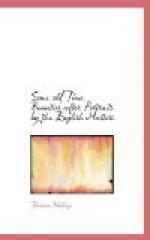In an ode on the death of Maria the poet Mason wrote:—
“For she was fair beyond your
brightest bloom
(This Envy owns, since
now her bloom is fled):
Fair as the Forms that wove in Fancy’s
loom,
Float in light vision
round the Poet’s head.
Whene’er with soft serenity
she smiled,
Or caught the orient
blush of quick surprise,
How sweetly mutable, how brightly
wild.
The liquid lustre darted
from her eyes!
Each look, each motion, waked a
new-born grace
That o’er her
form its transient glory cast:
Some lovelier wonder soon usurped
the place,
Chased by a charm still
lovelier than the last.”
[Illustration: ELIZABETH COUNTESS GROSVENOR by LAWRENCE]
LADY ELIZABETH
In these latter days can we imagine a lawsuit, costing contestants thousands of pounds, over the right to a certain heraldic charge? In the fourteenth century Sir Robert Grosvenor was the defendant in such a suit, and we read of Chaucer, John of Gaunt, Owen Glendower, and Hotspur being witnesses before the High Court of Chivalry. Sir Robert established his defence, and since those days the Grosvenors have ever held a high rank in the nobility of England. Quite as proud a patrician position was held through the centuries by the family of Gower. In the early part of this century, the heir of the Grosvenors espoused the most beautiful daughter of the House of Gower,—Lady Elizabeth Mary Leveson Gower. This lady was the youngest daughter of George, the second Marquis of Stafford, who married, in 1785, Elizabeth, who was Countess of Sutherland and Baroness Strathnaver in her own right. The Marquis was created Duke of Sutherland in 1833.




